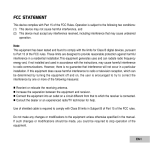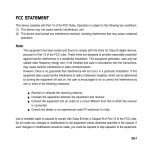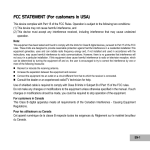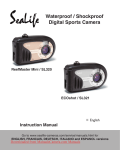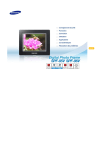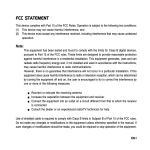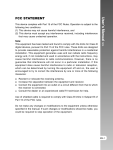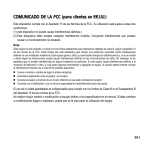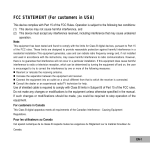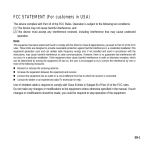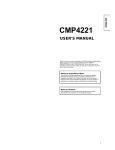Download Minox DC 6033 WP User Guide
Transcript
FCC STATEMENT This device complies with Part 15 of the FCC Rules. Operation is subject to the following two conditions: (1) This device may not cause harmful interference, and (2) This device must accept any interference received, including interference that may cause undesired operation. Note: This equipment has been tested and found to comply with the limits for Class B digital devices, pursuant to Part 15 of the FCC rules. These limits are designed to provide reasonable protection against harmful interference in a residential installation.This equipment generates uses and can radiate radio frequency energy and, if not installed and used in accordance with the instructions, may cause harmful interference to radio communications. However, there is no guarantee that interference will not occur in a particular installation. If this equipment does cause harmful interference to radio or television reception, which can be determined by turning the equipment off and on, the user is encouraged to try to correct the interference by one or more of the following measures: Reorient or relocate the receiving antenna. Increase the separation between the equipment and receiver. Connect the equipment into an outlet on a circuit different from that to which the receiver is connected. Consult the dealer or an experienced radio/TV technician for help. Use of shielded cable is required to comply with Class B limits in Subpart B of Part 15 of the FCC rules. Do not make any changes or modifications to the equipment unless otherwise specified in the manual. If such changes or modifications should be made, you could be required to stop operation of the equipment. EN-1 READ THIS FIRST Trademark Information Microsoft® and Windows® are U.S. registered trademarks of Microsoft Corporation. Pentium® is a registered trademark of Intel Corporation. Macintosh is a trademark of Apple Computer, Inc. SDTM is a trademark. Photo Explorer and Photo Express are trademarks. Other names and products may be trademarks or registered trademarks of their respective owners. Product Information Product design and specifications are subject to change without notice. This includes primary product specifications, software, software drivers, and user’s manual. This User Manual is a general reference guide for the product. The product and accessories that come with your digital camera may be different from those described in this manual. This is due to the fact that different retailers often specify slightly different product inclusions and accessories to suit their market requirements, customer demographics, and geographical preferences. Products very often vary between retailers especially with accessories such as memory cards, cables, carrying cases/pouches, and language support. Occasionally a retailer will specify a unique product color, appearance, and internal memory capacity. Contact your dealer for precise product definition and included accessories. The illustrations in this manual are for the purpose of explanation and may differ from the actual design of your digital camera. The manufacturer assumes no liability for any errors or discrepancies in this user manual. EN-2 SAFETY INSTRUCTIONS Read and understand all Warnings and Cautions before using this product. Warnings If foreign objects or water have entered the camera, turn the power OFF and remove the batteries. Continued use in this state might cause fire or electric shock. Consult the store of purchase. If the camera has fallen or its case has been damaged, turn the power OFF and remove the batteries. Continued use in this state might cause fire or electric shock. Consult the store of purchase. Do not disassemble, change or repair the camera. This might cause fire or electric shock. For repair or internal inspection, ask the store of purchase. Do not place the camera on inclined or unstable surfaces. This might cause the camera to fall or tilt over, causing injury. Keep the batteries out of the reach of children. Swallowing batteries might cause poisoning. If the battery is accidentally swallowed, immediately consult a physician. Do not use the camera while you are walking, driving or riding a motorcycle. This might cause you to fall over or result in traffic accident. EN-3 Cautions Insert the batteries paying careful attention to the polarity (+ or –) of the terminals. Inserting the batteries with polarities inverted might cause fire and injury, or damage to the surrounding areas due to the battery rupturing or leaking. Do not fire the flash close to anyone’s eyes. This might cause damage to the person’s eyesight. Do not subject the LCD monitor to impact. This might damage the glass on the screen or cause the internal fluid to leak. If the internal fluid enters your eyes or comes into contact with your body or clothes, rinse with fresh water. If the internal fluid has entered your eyes, consult a physician to receive treatment. A camera is a precision instrument. Avoid drops, impact or excessive force when handling the camera. This might cause damage to the camera. Do not remove the battery immediately after a long period of continuous use. The battery becomes hot during use. Touching a hot battery might cause burns. Do not wrap the camera or place it in cloth or blankets. This might cause heat to build up and deform the case, resulting in fire. Use the camera in a well-ventilated place. Do not leave the camera in places where the temperature may rise significantly, such as inside a car. This might adversely affect the case or the parts inside, resulting in fire. Before you move the camera, disconnect cords and cables. Failure to do this might damage cords and cables, resulting in fire and electric shock. EN-4 Notes on Battery Usage Carefully read and strictly observe the Safety Instructions and the notes described below: Different battery types and surrounding temperatures may affect the battery performance. Avoid using batteries in extremely cold environments as low temperatures can shorten the battery life and reduce camera performance. The battery may feel warm after a long period of continuous use of the camera or the flash. This is normal and not a malfunction. The camera may feel warm after a long period of continuous use. This is normal and not a malfunction. If the camera is not to be used for a long period of time, remove the batteries from the camera to prevent leakage or corrosion. Never use batteries of different types (together) or mix old and new batteries. Always keep the terminals clean. Never use manganese batteries. There is a risk of explosion if the batteries are replaced by an incorrect type. Dispose of used batteries according to the instructions. Notes on Waterproof Function Do not place the camera directly on the sand at the beach or similar places. The camera will sink if dropped in water, so be sure to attach the strap and slip the strap over your wrist when using the camera in or near water. The silicone O-ring (located on the inside of the waterproof door) must be perfectly clean before each use. Refer to important O-ring case instructions in this manual. Be sure to check that the waterproof door is securely locked before using the camera in an environment where it is likely to get wet or dirty, such as underwater or at the beach. Water, sand or dirt inside the camera may cause failure of the camera. Wipe off any water or dirt with a dry cloth as soon as possible after using the camera. Avoid opening the waterproof door at the beach or by the sea. Wait until the camera is completely dry before changing the batteries or the SD memory card. Avoid changing the batteries or card where the camera is likely to get wet or dirty, and make sure that your hands are dry. If the camera is very dirty or after it has been used in the sea, make sure that it is turned off and the waterproof door is firmly closed before rinsing it under running tap water or leaving it in a bowl of clean water for a short time (2 or 3 minutes) Avoid getting sunscreen or suntan oil on the camera as it may cause discoloration of the surface. If any oil gets on the camera, wash it off immediately with warm water. The waterproof function does not apply to the camera’s accessories. EN-5 CONTENT INTRODUCTION ........................................................................................................... 8 Package Contents ............................................................................................................. 9 GETTING TO KNOW YOUR CAMERA ....................................................................... 10 Front View .......................................................................................................................... 10 Rear View ........................................................................................................................... 11 LCD Monitor Information .................................................................................................... 12 PREPARING THE CAMERA ........................................................................................ 14 Installing the Batteries ...................................................................................................... 14 Inserting and Removing an SD Memory Card (Optional Accessory) ................................ 15 Attaching the Camera Strap .............................................................................................. 16 LED Indicators ................................................................................................................... 16 GETTING STARTED .................................................................................................... 17 Turning the Power On/Off .................................................................................................. 17 Choosing the Screen Language ........................................................................................ 17 Setting the Date and Time ................................................................................................. 18 Formatting an SD Memory Card or Internal Memory ......................................................... 19 PHOTOGRAPHY MODE .............................................................................................. 20 Shooting Images - The Basics .......................................................................................... 20 Setting Image Resolution and Quality ............................................................................... 20 Using the Zoom Function ................................................................................................... 21 Setting Focus .................................................................................................................... 21 Using the Flash .................................................................................................................. 22 Using the Self-Timer .......................................................................................................... 23 Adjusting the Exposure (EV Compensation) ..................................................................... 23 Setting White Balance ....................................................................................................... 24 Setting Manual White Balance .......................................................................................... 24 Scene Mode Selection ....................................................................................................... 26 PLAYBACK MODE - THE BASICS ............................................................................. 27 Viewing Images .................................................................................................................. 27 Magnifying Images ............................................................................................................. 28 Thumbnail Display .............................................................................................................. 29 Slideshow Display .............................................................................................................. 30 VIDEO MODE ............................................................................................................... 31 Recording Video Clips ....................................................................................................... 31 Playing Back Video Clips .................................................................................................. . 31 EN-6 PLAYBACK MODE – ADVANCED FEATURES ......................................................... 32 Deleting Images/Video Clips .............................................................................................. 32 Protecting Images/Video Clips .......................................................................................... 33 Setting the DPOF ............................................................................................................... 34 Connecting to a PictBridge Compliant Printer ................................................................... 36 TAKING UNDERWATER PICTURES .......................................................................... 38 MUST DO for Underwater Use ........................................................................................... 38 How to Install and Remove O-ring ..................................................................................... 39 Maintaining a Waterproof Seal .......................................................................................... 40 Using and Cleaning the Camera Underwater ..................................................................... 41 Great Underwater Pictures Made Easy ............................................................................. 42 TRANSFERRING FILES FROM YOUR DIGITAL CAMERA TO COMPUTER .......... 43 Step 1: Connect the digital camera to your computer ...................................................... 43 Step 2: Download images or video clips ........................................................................... 44 EDITING SOFTWARE INSTALLATION ...................................................................... 45 Installing Photo Explorer ................................................................................................... 45 Installing Photo Express ................................................................................................... 45 USING THE DIGITAL CAMERA AS A PC CAMERA ................................................. 46 Step 1: Install the PC camera driver ................................................................................. 46 Step 2: Connect the digital camera to your computer ...................................................... 47 Step 3: Run your application software (i.e. Windows NetMeeting) .................................. 47 MENU OPTIONS .......................................................................................................... 48 Camera Menu ..................................................................................................................... 48 Video Menu ........................................................................................................................ 50 Playback Menu .................................................................................................................. 51 Setup Menu ........................................................................................................................ 52 SPECIFICATIONS ........................................................................................................ 53 TROUBLESHOOTING GUIDE ..................................................................................... 54 EN-7 INTRODUCTION Overview Let the Land & Sea adventures begin with your new waterproof/shockproof digital camera. Equipped with the latest digital technology, the camera is automatic and easy to use. Here are some of the features that you will surely enjoy. 6.0 Megapixels DPOF can be used to print your provides 6.0 megapixels for high images on a DPOF compatible printer image quality. Auto flash An auto flash sensor automatically d e t e c t s the shooting (lighting) conditions and determines whether the flash should be used. 2.0” LTPS color image LCD monitor Digital zoom: 1x~4x 16MB internal (built-in) memory (14MB available for image storage) Images can be captured without using a memory card. Support for SD memory card for by simply inserting the memory card. PictBridge support You can connect the camera directly to a printer that supports PictBridge and perform image selection and printing using the camera monitor screen and controls. Scene mode You may select a previously set recording mode for the following situations: Auto, Sport, Night, Portrait, Landscape, Backlight, Underwater, Beach, Fireworks. Provided editing software: Photo memory expansion Explorer / Photo Express You may expand the memory You can enhance and retouch your capacity (up to 2GB) by using an images on your computer by using external mrmory card. the provided editing software. USB connection (USB 2.0 compliant) Still images, video clips, or voice recording files that you have recorded can be downloaded to your computer using the USB cable. EN-8 DPOF functionality A high-resolution CCD sensor Package Contents Carefully unpack your kit box and ensure that you have the following items. In the event that any item is missing or if you find any mismatch or damage, promptly contact your dealer. Common Product Components: Digital Camera User’s Manual Camera Strap USB Cable Camera Pouch Software CD-ROM 2 x AA Alkaline batteries Spare O-ring Desiccant Common (Optional) Accessories: SD memory card Accessories and components may vary by retailer. EN-9 GETTING TO KNOW YOUR CAMERA Front View 7 8 9 1 2 6 3 5 4 1. Shutter button 2. Flash 3. Lens 4. Waterproof door 5. Latch 6. Latch lock 7. PC/USB terminal 8. Battery cover 9. SD memory card slot EN-10 Rear View 1 2 3 4 11 5 6 10 7 9 1. W Arrow button (Left) Self-timer button 2. S Arrow button (Up) MENU button 3. OK button Power switch / Digital zoom button 4. Playback button 5. X Arrow button (Right) Flash button 8 6. T Arrow button (Down) MODE button 7. Strap holder 8. Tripod socket 9. LCD monitor 10. Focus switch Macro mode Normal mode 11. Status LED EN-11 LCD Monitor Information Camera Mode A 1. Internal memory/SD memory card indicator [ ] Status of internal memory [ ] Status of SD memory card 2. Remaining battery status [ ] Full battery power [ ] Medium battery power [ ] Low battery power [ ] No battery power 3. Flash mode [Blank] Auto [ ] Red-eye Reduction [ ] Forced Flash [ ] Flash Off 4. Focus area 5. Image size [ ] 2816 x 2112 [ ] 2272 x 1704 [ ] 1600 x 1200 [ ] 640 x 480 6. Possible number of shots 7. Quality [ ] Fine [ ] Standard [ ] Economy 8. Date and time 9. Self-timer icon [ 10s]10 sec. [ 2s ] 2 sec. [ 10+2s ] 10+2 sec. 10. Unsteady hold warning icon EN-12 0.3 02/05/2006 08:03 ] Exposure compensation 11. [ 12. White balance [Blank] Auto [ ] Daylight [ ] Cloudy [ ] Tungsten [ ] Fluorescent [ ] Manual WB [Less 15 Feet] [Over 15 Feet] 13. Focus mode ] Macro [ [ ] Normal 14. Scene mode [A] Auto [ ] Sport [ ] Night [ ] Portrait [ ] Landscape [ ] Backlight [ ] Underwater [ ] Beach [ ] Fireworks Video Mode 1. 2. 3. 4. 5. 3 2 Video mode 1 Recordable movie time available SD memory card indicator (if present) Battery power indicator 5 Focus area 00:00:33 4 2 Image Playback 1. 2. 3. 4. 3 1 Playback mode SD memory card indicator (if present) 4 Battery power indicator Playback information 100-0001 Size EV. 2006.02.10 2272 x 1704 0.3 10:26 0001 Video Playback 1. 2. 3. 4. 5. 6. 7. 3 2 1 Playback mode Video mode 6 Total recorded time SD memory card indicator (if present) 7 Battery power indicator Playback indicator Playback information 4 5 00:00:26 100-0002 Size EV. 2006.02.10 320X240 0.3 09:34 0002 EN-13 PREPARING THE CAMERA Installing the Batteries Use 2 AA size batteries to power the camera. Make sure that the power is off before inserting or removing the batteries. 1. Slide the latch lock to unlock the latch and open the waterproof door as shown in the illustration. 2. Open the inside battery cover and insert the batteries in the correct orientation as shown in the illustration. 3. Close both the battery cover and waterproof door and lock the latch. To remove the batteries,turn the camera off before removing batteries and hold the camera with the waterproof door facing sideways, then open the door. 1 3 2 Important: Make sure that you and the camera are dry before opening the waterproof door. Be careful not to drop the batteries when opening or closing the battery cover. Opening the waterproof door with the camera held sideways will prevent waterdrops from entering the internal electronic areas. EN-14 Inserting and Removing an SD Memory Card (Optional Accessory) The digital camera comes with 16MB of internal memory (14MB available for image storage), allowing you to store captured still images or video clips in the digital camera. You can also expand the memory capacity by using an optional SD (Secure Digital) memory card so that you can store more files. 1. Make sure your camera is turned off before inserting or removing a memory card. 2. Open the waterproof door and then the inside battery cover. 3. Insert an SD memory card in the correct orientation as shown in the illustration. 4. Close both the battery cover and waterproof door and lock the latch. To remove the SD memory card, make sure the camera is turned off. Press lightly on the edge of the memory card and it will eject. Be sure to format an SD memory card with this digital camera before using it. Refer to section in the manual titled “Formatting an SD Memory Card or Internal Memory” for further details. To prevent valuable data from being accidentally erased from an SD card, you can slide the write protect tab (on the side of the SD memory card) to “LOCK”. To save, edit, or erase data on an SD memory card, you must unlock the card. EN-15 Attaching the Camera Strap Attach the strap as shown in the illustration. LED Indicators Color Green Green EN-16 State Solid Flashing During photography Ready for shot. Accessing files in progress. Flash charging in progress. During connection to a PC System ready. Accessing files in progress. GETTING STARTED Turning the Power On/Off Load the batteries and insert an SD memory card before starting. J J To turn the power on, push and hold the OK button until the camera turns on. To turn the power off, push and hold the OK button until the camera turns off. J The power is turned off automatically when the camera has not been operated for a fixed time period. To resume operation, turn the power on again. Refer to section in this manual titled “Auto Off” in the Setup Menu for further details. Choosing the Screen Language Follow the steps below to choose the desired language. 1. Push and hold the OK button until the camera turns on. The camera mode (default preview) is displayed. 2. Press the S / button and access the setup menu with the X button. In the video [ ] mode or playback [ ] mode, you may also follow the step above Ex.: In Camera Mode to access the setup menu. 3. Select [Language] with the S / T buttons, then press the OK button. The Language setting screen will be displayed. 4. Select the displayed language with the S / T buttons, then press the OK button. The setting will be stored. 5. To exit from the menu, press continuously the W button. EN-17 Setting the Date and Time Follow the steps below to set the date display style, current date and time. 1. Push and hold the OK button until the camera turns on. button and access the setup 2. Press the S / menu with the X button. 3. Select [Date/Time] with the S / T buttons, then press the OK button. 4. Select the item’s field with the W / X buttons and adjust the value for the date and time with the S / T buttons. The date and time is set in the order yearmonth-day-hour-minute. The time is displayed in 24-hour format. 5. After confirming all settings are correct, press the OK button. 6. To exit from the menu, press continuously the W button. Ex.: In Camera Mode EN-18 Formatting an SD Memory Card or Internal Memory The term “Formatting” means preparing an “SD Memory Card” to record images; this process is also called “initialization”. This utility formats the internal memory (or memory card) and erases all stored images and data. 1. Push and hold the OK button until the camera turns on. 2. Press the S / button and access the setup menu with the X button. 3. Select [Format] with the S / T buttons, then press the OK button. 4. Select [Execute] with the S / T buttons, then press the OK button. To cancel formatting, select [Cancel] and press the OK button. 5. To exit from the menu, press continuously the W button. Ex.: In Camera Mode When you format an SD memory card, be aware that all data will be permanently erased. Protected images are also erased. To format the internal memory, do not insert a memory card into the camera. Otherwise, you will format the memory card. Formatting is an irreversible action and data cannot be recovered at a later time. An SD memory card having any problem cannot be properly formatted. EN-19 PHOTOGRAPHY MODE Shooting Images - The Basics 1. Push and hold the OK button until the camera turns on. 2. Compose the image on the monitor screen so that the main subject is within the focus frame. 3. Press the shutter button to capture the image. A 0.3 02/05/2006 08:03 The captured image appears to be larger than the one appearing on the LCD during preview. Setting Image Resolution and Quality As you get to know the digital camera, you can set the image resolution (number of vertical and horizontal pixels) and image quality (compression ratio) based on the types of images you want to shoot. These settings affect the number of images that can be stored in memory, or on a memory card. Higher resolution and higher quality images provide finer detail but cause the images’ file size to be larger. To change image resolution or image quality, perform these steps below: 1. Push and hold the OK button until the camera turns on. 2. Press the S / button. 3. Select [Size] with the S / T buttons, then press the OK button. 4. Select the desired setting with the S / T buttons, then press the OK button. 5. Select [Quality] with the S / T buttons, then press the OK button. 6. Select the desired setting with the S / T buttons, then press the OK button. 7. To exit from the menu, press the W button. The possible number of shots and recording time depend on the storage size, resolution and quality settings and the subject of the image to be captured. EN-20 Using the Zoom Function This camera is equipped with 4x digital zoom. You can enlarge the subjects by continuing to press the OK button. As useful as this feature is, you should remember that the more the image is magnified, the grainier the image may become. To capture a zoomed image, perform the following steps: 1. Push and hold the OK button until the camera turns on. 2. To activate the digital zoom, push and release the OK button. Each push and release of the OK button will increase the zoom up to 4X. 3. Compose your scene and press the shutter button to capture the image. The digital magnification ranges from 1.0x to 4.0x. As you record video clips, the zoom function cannot be activated. Setting Focus Images can be captured by sliding the focus switch to set the focus modes: [ ] macro or [ ] normal mode. 1. Push and hold the OK button until the camera turns on. 2. Slide the focus switch to your desired focus mode. 3. Compose your scene and press the shutter button. The table below will help you choose the appropriate focus mode: Focus mode Normal Macro Description This mode is suitable for shooting distance of 1m to infinity. Select Macro to capture close-up images at shooting distance of 60cm to 1m. Underwater focus range will vary because of the water's magnification effect. Normal focus range is 75cm to infinity. Macro focus is 45cm to 75cm. EN-21 Using the Flash The flash is designed to function automatically when lighting conditions warrant the use of flash. The camera has four flash modes: Auto Flash (default), Red-eye Reduction, Forced Flash and No Flash. You can take an image using a desired flash mode to suit your circumstances. 1. Push and hold the OK button until the camera turns on. 2. Toggle the X / button until your desired flash mode appears on the LCD monitor. 3. Compose your scene and press the shutter button. The table below will help you to choose the appropriate flash mode: Flash mode EN-22 Description Auto The flash fires automatically according to the photographic conditions. Red-eye Reduction Use this mode to reduce the red-eye phenomenon when you want to take natural-looking photographs of people and animals in low-light conditions. When taking photographs, the red-eye phenomenon can be reduced by asking the subject to look away from the camera and increasing the lighting. Forced Flash The flash will always fire regardless of the surrounding brightness. Select this mode for recording images with high contrast (backlighting) and deep shadows. Flash Off Use this mode when flash use is prohibited or the distance to the subject is too far away for the flash to have any effect. Using the Self-Timer The self-timer can be used in situations such as group shots. When using this option, you should either mount the camera on a tripod (recommended) or rest it on a flat, level surface. 1. Secure the camera to a tripod or place it on a stable surface. 2. Push and hold the OK button until the camera turns on. 3. Toggle the W / button until your desired self-timer mode appears on the LCD monitor. OFF 10s [ No Indication] 2s 10+2s 4. Compose your scene and press the shutter button. The self-timer function is activated. The photograph is then taken after the preset time. To cancel the self-timer at any time, press the W / sequence. button to interrupt the After one shot is taken, the self-timer mode is turned off. If you wish to take another image using the self-timer, repeat these steps. Adjusting the Exposure (EV Compensation) You can manually adjust the exposure determined by the digital camera. Use this mode when the proper exposure cannot be obtained, for example, when the contrast (difference) between the light and dark of the subject and the background is extremely large. The EV compensation value can be set in the range from –2.0EV to +2.0EV. 1. Push and hold the OK button until the camera turns on. 2. Press the S / button. 3. Select [EV] with the S / T buttons, then press the OK button. 4. Use S or T button to set the range of EV compensation value from -2.0EV to +2.0EV, then press the OK button. 5. To exit from the menu, press the W button. Ex.: In Camera Mode EN-23 Setting White Balance This feature lets you make adjustments to compensate for different lighting types according to your shooting conditions. 1. Push and hold the OK button until the camera turns on. 2. Press the S / button. 3. Select [White Balance] with the S / T buttons, then press the OK button. 4. Select the desired setting with the S / T buttons, then press the OK button. 5. To exit from the menu, press the W button. Ex.: In Camera Mode Setting Manual White Balance You can manually set and store the white balance when the menu options do not offer a good match. 1. Push and hold the OK button until the camera turns on. 2. 3. 4. 5. Press the S / button. Select [White Balance] with the S / T buttons, then press the OK button. Select [Manual WB] with the S / T buttons, then press the OK button. Point the camera at an 8.5” x 11” ( A4) sheet of white paper (or white slate). Hold the paper (or slate) at arms length and press the OK button to [Execute]. The manual white balance is now stored in the camera. 6. To cancel the white balance setting, repeat the above process and select [Cancel] in step 5. It may be helpful to hold the paper (or slate) at an angle, midway between the light source and the camera. EN-24 Scene Mode Selection You can select the scene mode according to your shooting requirements. There are 9 available scene modes. [ A ] Auto: Select this mode to adjust point-and-shoot action. [ ] Sport: Select this mode when you want to photograph fast-moving subjects. [ ] Night: Select this mode when you want to take pictures outdoors at night. [ ] Portrait: Select this mode when you want to capture an image that makes the person stand out against the background. [ ] Landscape: Select this mode to capture an image with hard sharpness and high saturation. [ ] Backlight: Select this mode when you want to capture images when the light [ ] Underwater: Select this mode when you want to capture underwater photos. [ ] Beach: Select this mode when you want to capture bright beach scenes and sunlit water surfaces. [ ] Fireworks: Select this mode when you want to capture fireworks clearly with comes from behind the object. optimal exposure. The shutter speed becomes slower, so using a tripod is recommended. 1. Push and hold the OK button until the camera turns on. 2. Press the S / button. 3. Select [Scene Mode] with the S / T buttons, then press the OK button. 4. Select the desired scene mode with the S / T buttons, then press the OK button. 5. To exit from the menu, press the W button. EN-25 PLAYBACK MODE - THE BASICS Viewing Images You can display the still images you have just captured. 1. Push and hold the OK button until the camera turns on. 2. Press the [ ] button. The last recorded image appears on the LCD monitor. 100-0001 3. Use W or X button to select the desired 2272 X1704 Size images. 0.3 EV. To view the previous image, press the W 09:26 2006.02.10 button. 0001 To view the next image, press the X button. 4. To exit from playback mode, press the [ ] or T (MODE) button. The playback information displayed on the LCD monitor will disappear after a few seconds. If there is no image stored in the internal memory or on the memory card, a [NO IMAGE] message will appear on the monitor. EN-26 Magnifying Images While reviewing your images, you may enlarge a selected portion of an image. This magnification allows you to view fine details. The zoom factor displayed on the screen shows the current magnification ratio. 2.0X T T T 1. Push and hold the OK button until the camera turns on. 2. Press the [ ] button. 3. Continuously push and release the OK button to zoom in on the picture. The magnification factor is displayed on the LCD monitor. 4. To view different portions of the images, press the S / T / W / X button to adjust the display area. T 0001 The magnification factors range from 1x to 4x (within 7 stages: 1.0x, 1.5x, 2. 0x, 2.5x, 3.0x, 3.5x and 4.0x). EN-27 Thumbnail Display This function allows you to view 9 thumbnail images on the LCD monitor simultaneously so you may search for a particular image. 1. Push and hold the OK button until the camera turns on. 2. Press the [ ] button. 3. Continuously push and release the OK button until the thumbnail images are displayed. For recorded video clips, the [ ] video mode icon will be displayed. 4. Use the S / T / W / X button to move the cursor to select the image to be displayed at regular size. 5. Press the OK button to display the selected image on full screen. 1 2 3 4 5 6 7 8 9 100 - 0003 If the first displayed file is a video clip, use W / X buttons to select an image file, then press continuously the OK button to display the thumbnail. In playback [ ] mode, you may also display the thumbnail by the following steps: 1. Press the S / button to access the playback menu. 2. Select [Thumbnail] with the S / T buttons, then press the OK button. EN-28 Slideshow Display The slide show function enables you to play your images back automatically in sequential order. This is a very useful and entertaining feature for reviewing recorded images and for presentations. 1. Press the [ ] button. 2. Press the S / button. 3. Select [Slide Show] with the S / T buttons, then press the OK button. 4. Use S / T to select the playback interval, then press the OK button. The slideshow starts. 5. To stop the slide show during playback, press the OK button. You can adjust the slide show display interval within the range of 3 Sec., 5 Sec., 10 Sec. The Auto Off function does not operate during slide show. All still images in the folder are automatically played back. Video clips are displayed the first frame image, and they are not played back. Slideshow display is only activated when more than 2 images are stored in the SD card/internal memory. EN-29 VIDEO MODE Recording Video Clips This mode allows you to record video clips with sound via the built-in microphone. 1. Push and hold the OK button until the camera 00:00:33 turns on. 2. Press T / MODE and switch to [ ] mode. 3. Press the shutter button to start recording. 4. To stop recording, press the shutter button again. When recording a video clip, the flash cannot be used. Sound recording with video is optimized for underwater use. The camera’s waterproof case will limit audio performance in air. Playing Back Video Clips You can play back recorded video clips. A guide to operation appears on the LCD monitor during the video playback. ] button. 1. Press the [ 2. Use W or X to go through the images until the video clip you want to play back is displayed. 3. Press the OK button to start playing back the video clips. To pause or resume video playback, press the OK button again. Press the [MODE] button while the video clip is paused to return to the beginning of the video clip 00:00:26 100-0002 Size EV. 2006.02.10 320X240 0.3 10:34 0002 The playback information displayed on the LCD monitor will disappear after a few seconds. The zoom function cannot be activated while playing the video clips back. To playback the video clips on the computer, we recommend you to use Windows Media Player 9.0 (WMP 9.0) or later.You can download the latest WMP version from the website at www.microsoft.com. If the video can’t be play back in the WMP 9.0, you have to update the renewed of WMP 9.0 from the Microsoft website. EN-30 PLAYBACK MODE – ADVANCED FEATURES Deleting Images/Video Clips Use this function to delete one or all images/video clips stored in the internal memory or memory card. Please note that the deleted images or video clips cannot be recovered. Exercise caution before deleting a file. Deleting in Playback Mode 1. Press the [ ] button. 2. Select the image you want to erase with the W / X buttons. 3. Press the S / button. 4. Select [Delete] with the S / T buttons, then press the OK button. 5. Select [Single] or [All] with the S / T buttons, then press the OK button. J Single: Delete the displayed image or the last image. J All: Delete all of the images on the SD memory card except for the protected images. J Select: Select the image from the thumbnail display and then delete it. 6. Select [Execute] with the S / T buttons, then press the OK button. J To cancel deletion, select [Cancel], then press the OK button. Deleting Selected Image 1. Press the [ ] button. 2. Press the S / button. 3. Select [Delete] with the S / T buttons, then press the OK button. 4. Select [Select] with the S / T buttons, then press the OK button. J The images are displayed in the thumbnail display. 5. Select the image you want to delete with the S / T / W / X buttons, then press the OK button. J The image you’ve just selected has been deleted. As a shortcut, you can delete any image while in playback mode by pushing the shutter button. This will display the [Delete This Picture?] message. EN-31 Protecting Images/Video Clips Set the data to read-only to prevent images from being erased by mistake. Protecting Images 1. Press the [ ] button. 2. Select the image that you want to protect with the W / X buttons. 3. 4. 5. 6. Press the S / button. Select [Protect] with the S / T buttons, then press the OK button. Select [Single] or [All] with the S / T buttons, then press the OK button. Select [Set] with the S / T buttons, then press the OK button. J Press continuously the W button to return to the playback mode. J The protect icon [ ] is displayed with the protected image. To Cancel the Protection To cancel protection for only one image, display the image that you want to remove the image protection. 1. Select [Protect] with the S / T buttons from the playback menu, then press the OK button. 2. Select [Single] or [All] with the S / T buttons, then press the OK button. 3. Select [Cancel] with the S / T buttons, then press the OK button. J Press continuously the W button to return to the playback mode. The removal of image protection has been executed. Protecting Selected Images 1. Select [Protect] with the S / T buttons from the playback menu, then press the OK button. 2. Select [Select] with the S / T buttons, then press the OK button. J The images are displayed in the thumbnail display. 3. Select the image you want to protect with the S / T / W / X buttons, then press the OK button. 4. If you want to cancel the protection of selected image respectively, follow the steps mentioned in “To Cancel the Protection” above to set. J EN-32 Formatting an SD memory card overrides protection, and erases all images regardless of their protected status. Setting the DPOF DPOF (Digital Print Order Format) allows you to embed printing information on your memory card. By using DPOF, you can select an image to be printed and then specify how many prints or which image you would like. Take your memory card to a DPOF enabled printer that accepts memory cards. The DPOF/card-compatible printer will read the embedded information on the memory card and print your images as specified. 1. Press the [ ] button. 2. Select the image that you want to set DPOF with the W / X buttons. button. 3. Press the S / 4. Select [DPOF] with the S / T buttons, and press the OK button. 5. Select [Single] or [All] with the S / T buttons, and press the OK button. J Single: Sets DPOF for each individual image. J All: Sets DPOF for all images at once. 6. Select [Print Num.] with the S / T buttons, and press the OK button. J This displays the number of prints setting screen. 7. Set the number of prints with the S / T buttons, and press the OK button. J You can set up to 9 prints for each image. 8. Select [Date Print] with the S / T buttons, and press the OK button. J The date setting screen appears. EN-33 9. Select [On] or [Off] with the S / T buttons, and press the OK button. J On: The date of the photograph will also be printed. J Off: The date of the photograph will not be printed. 10.Select [Print Enable] with the S / T buttons, and press the OK button. 11.Select [Execute] with the S / T buttons, and press the OK button. J This creates a file containing the DPOF information. When the operation is finished, press the W button continuously to return to the playback mode. J The DPOF icon [ ] is displayed on each image that has DPOF settings. J J J EN-34 1 100-0001 The date that is printed on the photo is the date set on the camera. To print the correct date on the photo, set the date on the camera before you photograph the image. Refer to section in this manual titled “Setting the Date and Time” for further details. Before you perform the DPOF settings on your camera, always remember to copy your images from the internal memory to an SD memory card first. You cannot print movies. Connecting to a PictBridge Compliant Printer If a printer that supports PictBridge is available, images can be printed by connecting the digital still camera directly to the PictBridge-compatible printer without using a computer. Connecting the camera to the printer 1. Connect the USB port on the camera and the USB jack on the printer with the supplied USB cable, then turn on your camera and the printer. The screen for selecting the USB mode is displayed. 2. Select [PictBridge] and press the OK button. Printing images When the camera is properly connected to a PictBridge compliant printer, the PictBridge menu is displayed on the monitor. 1. Select the item you want to configure with the S/ T buttons, and press the OK button. [Images]: Select whether you want to print specific image or all images. You may also select printing number for specific image. [Date Print]: According to the printer type, select whether you want to print the image with date imprint or not. [Paper Size]: Select the desired paper size according to the printer type. [Layout]: Select the desired printing layout according to the printer type. [Print]: After all settings are configured, select [Print] and press the OK button to start printing. 2. If you select [Images] in the previous step, the figure shown on the right hand side will appear. Select [Select] or [All] with the S/T buttons, and press the OK button. [Select]: Select to print multi images simultaneously. [All]: Select to print all images. [Exit]: Exit from Images option. EN-35 3. If you select [Select] in the previous step, the figure shown on the right hand side will appear. J Select the multi images that you want to print simultaneously with the W/Xbuttons. J Select the [Print Num.] (up to 99) with the S/T buttons. J After selecting the desired image and printing number, press the OK button to confirm. 4. Select [Print] with the S/T buttons, and press the OK button to start printing. 5. The printing starts and the figure shown on the right hand side appears. J The [Complete] will be displayed temporarily, reminding you that the printing procedure is finished. J If a print error is detected, the [Print Error] will be displayed. The image printing may fail if the power to the camera is cut off. EN-36 TAKING UNDERWATER PICTURES MUST DO for Underwater Use 1. Read and understand the instructions contained in this manual before using the camera underwater. 2. Do not exceed the depth rating of 10m or the camera may leak. 3. Follow these important O-ring care instructions or the camera may leak. J Inspect and clean O-ring and O-ring contact surfaces for sand, hair and other debris before every use. J Inspect O-ring and O-ring contact surfaces for damage (cuts, scratches, tears, cracks, dents and any other imperfections.) Replace O-ring or have camera serviced if the O-ring or O-ring contact surfaces are damaged. Do not use camera if O-ring or O-ring contact surfaces are damaged. J Make sure O-ring is completely seated into O-ring groove before sealing waterproof door. O-ring must not be twisted when seated in the O-ring groove. Carefully follow O-ring removal and installation instructions contained in this manual. J Replace O-ring every year to ensure proper seal. J Soak and rinse camera in fresh water after each use. Use clean, soft cloth to dry camera. Store camera only after careful cleaning and when totally dry. 4. Carefully close waterproof door to seal camera. J Make sure O-ring does not slip out of the groove when sealing. J Make sure there are no obstructions that prevent waterproof door from sealing properly. 5. Never let any moisture or dirt get inside camera when opening. 6. For great underwater pictures you need: J Clear water conditions, control your buoyancy before taking pictures, get as close as possible to subject (ideal distance is 2’ to 6’) 7. Store camera at room temperature in a clean and dry place. J Do not expose camera to direct sunlight for prolonged periods. J Do not store camera in extreme high temperatures, such as the trunk of your car. EN-37 How to Install and Remove O-ring To remove O-ring, use a non-sharp object, like a credit card to lift up O-ring at one of the corners. To Install O-ring, carefully push O-ring into groove, making sure to align the shape of the o-ring with the shape of the groove. Be careful not to twist the O-ring. Important: Do NOT lubricate O-ring Carefully inspect and clean O-ring and O-ring contact surfaces before each underwater use. O-ring Waterproof Door EN-38 O-ring Contact surface Maintaining a Waterproof Seal Every camera is tested for quality and a waterproof seal. It is your responsibility to properly care for the O-ring and O-ring contact surfaces to maintain a waterproof seal. Carefully follow these important O-ring care instructions. Not following these care instructions may cause the camera to leak and void your warranty. 1. Carefully inspect O-ring and O-ring contact surfaces for damage (cuts, scratches, tears, cracks, dents and any other imperfections.) before every use. Rub finger along O-ring and O-ring contact surfaces to inspect for damage. Replace O-ring or have the camera serviced if the O-ring or O-ring contact surfaces are damaged. Do not use the camera if O-ring or O-ring contact surfaces are damaged. A B C Inspect and replace O-ring if damaged: A=Cut, B=Tear, C=Dent 2. Carefully inspect and clean O-ring and O-ring contact surfaces for sand, hair and other debris before every use. 1 2 Inspect and clean O-ring and O-ring contact surface for hair or fibers (#1) and Sand, Salt or debris (#2) 3. Make sure O-ring is completely seated into O-ring groove before sealing camera. O-ring must not be twisted when seated in the o-ring groove. 4. Replace O-ring every year to ensure proper seal. 5 . After each use underwater: a. Soak sealed camera in fresh water for about 15 minutes. Most dive boats offer special fresh water buckets specifically for underwater photo equipment. DO NOT put camera in fresh water designed for other dive equipment, like dive mask, because that water may contain detergents which are harmful to the camera. b. Push all the control buttons several times while the camera is soaking to clean out any salt water, sand or dirt that has accumulated during usage. c. Use clean, soft cloth to dry the camera. You and the camera must be dry before opening the waterproof door. EN-39 Using and Cleaning the Camera Underwater Entering the water with camera 1. Do not jump into the water with camera in your hand. Have someone hand you the camera after you have entered the water. 2. For tips on taking pictures, see “Great Underwater Pictures Made Easy”. After using camera underwater 1. Before entering dive boat, hand the camera to someone on the boat. 2. Make sure the sealed camera is placed in a fresh water tank available on most dive boats. This will clean the salt water from the camera and prevents the salt water from drying on the camera and O-ring. Never let water dry on the camera. Salt crystals can damage the O-ring, lens and attract moisture. Dry camera with clean soft towel after removing from fresh water tank. 3. Do not expose camera to direct sunlight - keep in a shaded area or under a dry towel. 4. It is not recommended to open the waterproof door while on the dive boat. Allowing humid air to enter the camera may cause fogging. 5. If you must open the camera while on the dive boat, make sure you and the camera are perfectly dry before opening the waterproof door. Do not allow the inside of the camera to get wet. Prepare camera for storage 1. Before storing the camera, remove batteries, SD card and keep in a clean dry area. Make sure the camera and any accessories are clean and dry before storage. 2. Never store camera in direct sunlight or in a dark damp area. Note – To protect your camera from a build up of moisture, insert the desiccant capsule into the battery compartment during storage. EN-40 Great Underwater Pictures Made Easy Taking underwater pictures is much different from taking land pictures. Here are the most important tips to taking great pictures underwater: 1. Crystal Clear water. Crystal Clear water is essential for good underwater pictures. Remember the human eye can see more detail than a camera. In other words, your eyes see the water as being clearer than it actually is. Floating particles like algae, and silt cause low visibility. Avoid stirring up the sandy bottom with your fins. These floating particles cause small spots to appear in your picture, known as “backscatter”. Always remember to limit your shooting distance to 1/10 of the water visibility. For example, if the visibility is 60 feet (18 m), you should keep your shooting distance to within 6 feet (1.8m); in 30 feet (9m) visibility you should be no further than 3 feet (90 cm) away from your subject. 2. Stay within the ideal shooting distance of 2 to 6 feet. The ideal shooting distance is between 2 to 6 feet (0.6 to 1.8 meters). This distance will result in detailed, colorful pictures. Remember that light does not travel very far underwater, so the closer you are to your subject the more colorful the pictures will be. 3. Move calmly and control your buoyancy before taking a picture. It is very hard to take good pictures when you are moving. Look around for great picture opportunities. First position yourself at the best angle, and neutralize your buoyancy. Second, use the LCD monitor to perfectly frame your subject, check your shooting distance and keep the camera steady. Third, be calm and patient: Sometimes you have to wait a little bit so the fish that were frightened away, come back. Don’t chase the fish, let the fish come to you. Always be in control of your buoyancy before taking pictures and observe all safe-diving rules. 4. Shoot many pictures of the same subject - If you don’t like it, delete it - later. One of the great advantages of digital cameras is that you can review and delete pictures later, so shoot several pictures of the same subject. One of the best ways to learn underwater photography is from your good pictures and bad pictures. 5. Evaluate picture for proper exposure and adjust exposure compensation as needed. Refer to section in this manual titled “Adjusting the Exposure” for more details. EN-41 TRANSFERRING FILES FROM YOUR DIGITAL CAMERA TO COMPUTER System Requirements Windows Pentium lll 600 MHz or higher Windows 2000/XP or later 64MB RAM 128MB hard disk space CD-ROM drive Available USB port Macintosh PowerPC G3/G4/G5 OS 9.0 or later 64MB RAM 128MB hard disk space CD-ROM drive Available USB port Step 1: Connect the digital camera to your computer 1. Push and hold the OK button until the camera turns on. 2. Connect one end of the USB cable to an available USB port on your computer. The USB screen appears on your camera’s LCD. 3. Use S / T to select [PC], then press the OK button. 4. From the Windows desktop, double click on “My Computer”. 5. Look for a new “Removable disk” icon. This “Removable disk” is actually the memory card in your camera. Typically, the camera will be assigned drive letter “e” or higher. 6. Double click on the removable disk and locate the DCIM folder. 7. Double click on the DCIM folder to open it to find more folders. Your recorded images and video clips will be inside these folders. Copy & Paste or Drag-N-Drop image and video files to a folder on your computer. (For Mac users, double-click the “untitled” or “unlabeled” disk drive icon on our desktop. iPhoto may automatically launch.) EN-42 Step 2: Download images or video clips When the digital camera is turned on and connected to your computer, it is considered to be a disk drive, just like a floppy disk or CD. You can download (transfer) images by copying them from the “Removable disk” (“untitled” or “unlabeled” disk on a Macintosh) to your computer hard drive. Windows Open the “removable disk” and double click on the DCIM / DSCIM folder to open it to find more folders. Your images are inside these folder(s). Select the desired still images or video clips and then choose “Copy” from the “Edit” menu. Open the destination location (folder) and choose “Paste” from the “Edit” menu. You may also drag and drop image files from the digital camera to a desired location. Macintosh Open the “untitled” disk icon, and the destination location on your hard disk. Drag and drop from the digital camera to the desired destination. Memory card users may prefer to use a memory card reader (highly recommended). A video playback application is not included with the package. Make sure that a video playback application has been installed in your computer. EN-43 EDITING SOFTWARE INSTALLATION Installing Photo Explorer Ulead ® Photo Explorer provides a simple and efficient way to transfer, browse, modify and distribute digital media. Acquire photos, video or sound clips from various digital device types and easily browse or add personal descriptions; make timely modifications; or distribute the media through the medium of your choice: E-mail, Print, Slideshow Presentations. It is an indispensable all-in-one tool for owners of digital cameras, WebCams, DV camcorders, scanners, or anyone who strives to effectively organize a large collection of digital media. 1. Insert the enclosed CD-ROM into your CD-ROM drive. 2. When the welcome screen appears, click “INSTALL PHOTO EXPLORER 8.0”. Follow the on-screen instructions to complete the installation. For more information about the operation of Photo Explorer application software, refer to its help documentation. For Windows 2000/XP users, please make sure to install Photo Explorer in “Administrator” mode. Photo Explorer is not supported on Mac. iPhoto or iPhoto2 is recommended. Installing Photo Express Ulead ® Photo Express is complete photo project software for digital images. The step-by-step workflow, visual program interface, and in-program help assist users in creating exciting photo projects. Acquire digital photos effortlessly from digital cameras or scanners. Organize them conveniently with the Visual Browse mode. Use hundreds of ready-to-use templates such as albums, cards, posters, slideshows, and more. Edit and enhance images with photo editing tools, photographic filters, and special effects. Embellish projects by adding creative design elements such as frames, callouts, and stamp objects. Share results with family and friends via e-mail and multiple print options. 1. Insert the enclosed CD-ROM into your CD-ROM drive. 2. When the welcome screen appears,click “INSTALL PHOTO EXPRESS 5.0”. Follow the on-screen instructions to complete the installation. For information on how to use Photo Express to edit and retouch your recorded images, please refer to its online help. For Windows 2000/XP users, make sure to install and use the Photo Express while logged in as a user with an Administrator account. Photo Express is not supported on Mac. EN-44 USING THE DIGITAL CAMERA AS A PC CAMERA Your digital camera can act as a PC camera, which allows you to videoconference with business associates, or have a real-time conversation with friends or family. To use the digital camera for videoconferencing, your computer system must include the items as below: Microphone Sound card Speakers or headphones Network or Internet connection Video conferencing (or video editing) software is not included with the digital camera. This mode is not supported for Mac. Step 1: Install the PC camera driver The PC-camera driver included in the CD-ROM is exclusively for Windows. The PC camera function is not supported for Mac platforms. 1. Insert the enclosed CD-ROM into your CD-ROM drive. 2. When the welcome screen appears, click “INSTALL PC-CAM DRIVER”. Follow the on-screen instructions to complete the installation. 3. After the driver installation is completed, restart your computer. EN-45 Step 2: Connect the digital camera to your computer 1. 2. 3. 4. Push and hold the OK button until the camera turns on. Connect one end of the USB cable to an available USB port on your computer. Use S / T to select [PC Camera], then press the OK button. Position the digital camera steadily on top of your computer monitor or use a tripod. When using this digital camera as a PC camera, it is necessary to install the batteries into the digital camera. Step 3: Run your application software (i.e. Windows NetMeeting) To use Windows NetMeeting for videoconferencing: 1. Go to Start Æ Programs Æ Accessories Æ Communications Æ NetMeeting to launch the NetMeeting program. 2. Click the Start Video button to view live video. 3. Click the Place Call button. 4. Type the e-mail address or the network address of the computer that you are calling. 5. Click Call. The person that you are calling must also have Windows NetMeeting running and be willing accept your call to start the videoconference. The video resolution for videoconferencing applications is generally 320 x 240. For more information about the operation of videoconference application software, refer to its respective help documentation. EN-46 MENU OPTIONS Camera Menu This menu is for the basic settings to be used when capturing still images. 1. Push and hold the OK button until the camera turns on. 2. Press the S / button. 3. Select the desired option item with the S / T buttons, then press the OK button to enter its respective menu. 4. Select the desired setting with the S / T buttons, then press the OK button. 5. To exit from the menu, press the W button. Size This sets the size of the image that will be captured. * [ ] 2816 x 2112 ] 2272 x 1704 * [ * [ ] 1600 x 1200 * [ ] 640 x 480 Quality This sets the quality (compression rate) at which the image is captured. * [ ] Fine * [ ] Standard * [ ] Economy Scene Mode Refer to section in this manual titled “Scene Mode Selection” for further details. EV Refer to section in this manual titled “Adjusting the Exposure (EV Compensation)” for further details. EN-47 White Balance This sets the white balance for a variety of lighting conditions and permits images to be captured that approach the conditions that are seen by the human eye. * * * * * * [ Blank ] Auto ] Daylight [ [ ] Cloudy [ ] Tungsten [ ] Fluorescent [ ] Manual WB In Underwater mode the following white balance options are displayed: * Auto / Less 15 Feet / Over 15 Feet / Manual WB Select the appropriate underwater depth for best white balance. Manual WB- This manually sets the white balance and stores it. Use of this is convenient when the white balance does not offer a good match. Refer to section in this manual titled “Setting Manual White Balance” for further details. ISO This sets the sensitivity for capturing images. When the image sensor sensitivity is raised (and the ISO figure is increased), photography will become possible even in dark locations, but the more pixelated (grainier) the image will appear. * Auto / 50 / 100 / 200 Color This sets the color of the image that will be photographed. * Standard / Vivid / Sepia / Monochrome Saturation To capture an image, your camera offers you three different degrees of color. Your images will show different effects with different degrees of color. This is called “Saturation”. * High / Normal / Low Sharpness This sets the sharpness of the image that will be photographed. * Hard / Normal / Soft EN-48 Preview This sets whether or not to display the captured image on the screen immediately after the image is captured. * On / Off Date Print The date of recording can be printed directly on the still images. This function must be activated before the image is captured. * On / Off Video Menu This menu is for the basic settings to be used when recording video clips. 1. Push and hold the OK button until the camera turns on. 2. Toggle the T / MODE button and switch to [ ] mode. 3. Press the S / button. 4. Select the desired option item with the S / T buttons,then press the OK button to enter its respective menu. 5. Select the desired setting with the S / T buttons, then press the OK button. 6. To exit from the menu, press the W button. EV Refer to section in this manual titled “EV” in Camera Menu for further details. White Balance Refer to section in this manual titled “White Balance” in Camera Menu for further details. Audio This sets whether to record video clips with audio and sets the volume. * High / Low / Off EN-49 Playback Menu In the [ ] mode, choose which settings are to be used for playback. 1. Press the [ ] button. 2. Press the S / button. 3. Select the desired option item with the S / T buttons, then press the OK button to enter its respective menu. 4. Select the desired setting with the S / T buttons, then press the OK button. 5. To exit from the menu, press the W button. Delete Refer to section in this manual titled “Deleting Images/Video Clips” for further details. Copy to Card Allows you to copy your files from the digital camera’s internal memory to a memory card. Of course, you can only do this if you have a memory card installed and some files in internal memory. * Cancel / Execute Slide Show Refer to section in this manual titled “Slideshow Display” for further details. DPOF Refer to section in this manual titled “Setting the DPOF” for further details. Protect Refer to section in this manual titled “Protecting Images/Video Clips” for further details. Thumbnail Refer to section in this manual titled “Thumbnail Display” for further details. EN-50 Setup Menu Set your camera’s operating environment. button and access the setup 1. Press the S / menu with the X button. 2. Select the desired option item with the S / T buttons, and press the OK button to enter its respective menu. 3. Select the desired setting with the S / T buttons, and press the OK button. Date/Time This sets the date and the time. Refer to section in this manual titled “Setting the Date and Time” for further details Format Erases all images and reformats the SD card loaded in your camera. Protected images are also erased. SD card cannot be formatted if it is write-protected. Refer to section in this manual titled “Formatting an SD Memory Card or Internal Memory” for further details. Beep This sets whether or not to mute the camera sound each time you press the camera button. * On / Off Language Refer to section in this manual titled “Choosing the Screen Language” for further details. Auto Off If no operation is performed for a specific period of time, the power to the camera is automatically turned off. This feature is useful to reduce battery wear. * 3 Min./ 5 Min./ 10 Min./ Off Sys. Reset This returns all basic settings to the camera’s default settings. The time setting will not be reset. * Cancel / Execute System Info. This displays the current firmware version of the camera. EN-51 SPECIFICATIONS Item Image Sensor Effective pixels Image size Description CCD 6.0 Mega pixels Still image: 2816 x 2112, 2272 x 1704, 1600 x 1200, 640 x 480 Video clip: 320 x 240 Image quality Still image: Fine, Standard, Economy Recording media 16MB internal memory (14MB available for image storage) SD memory card (Optional, up to 2GB) File format Image format: JPEG; video format: Motion JPEG Lens F-no.: 3.3 Focal length: 6.95mm (equivalent to a 42mm lens in 35mm file format) Focus range (Land) Macro: 60~100cm (24-40”) Normal: 100cm (40”) ~infinity Focus range (UW) Macro: 45~75cm Normal: 75cm~infinity LCD monitor 2.0” LTPS color LCD High-resolution 75K pixel display Self-timer 10 sec delay, 2 sec delay, 10+2 sec delay Exposure compensation -2.0EV~ +2.0EV (in 0.3EV increments) White balance Auto, Daylight, Cloudy, Tungsten, Fluorescent, Manual WB ISO Auto, 50, 100, 200 Interface USB connector Power 2 AA Alkaline or Ni-MH batteries (Optional) Dimensions Approx.120 x 78 x 43 mm (4.7 x 3.1 x 1.7”) Weight Approx. 230g (8.1oz) (without batteries and the SD memory card) Waterproof 30ft/10m * Design and specifications are subject to change without notice. EN-52 TROUBLESHOOTING GUIDE Symptom The power does not turn on. Possible causes Solutions / Corrective Actions * The batteries have run out. * Load new or fully charge * The batteries are not batteries. oriented correctly. * Load the batteries in the correct * The battery cover is not direction. closed properly. * Close the battery cover correctly. The camera suddenly * The function of Auto off * Set the option of Auto Off to in setup menu has been powers down. Off. activated. * Turn the power back on or * The batteries have run out. charge the batteries. The image is not * The camera is in * Toggle the T / MODE button to captured when the (Playback) mode. the camera mode. shutter button is * Memory is full. * Transfer the desired files to your pressed. computer and then delete unnecessary files, or use a different memory card. The flash does not fire. * NO FLASH is selected * Select a different flash mode. in flash mode. * Press the T / MODE and switch * The camera is in to the camera mode. Cannot transfer files over a USB connection. (Video) mode. * The USB cable is not connected securely. * The camera is turned off. * Check all connections. * Turn on the camera. EN-53 Possible Number of Recordable Images The frame counter indicates the approximate number of images that can be stored on the SD memory card. The number of recordable images may vary depending on the recorded subject, the capacity of the memory card, and whether there are files other than images or when the recording is made while switching the picture quality or resolution. Resolution Quality (Compression SD Memory Card Ratio) Fine (1/4) Standard (1/8) Economy (1/16) Fine (1/4) 2272 x 1704 Standard (1/8) Economy (1/16) Fine (1/4) 1600 x 1200 Standard (1/8) Economy (1/16) Fine (1/4) 640 x 480 Standard (1/8) Economy (1/16) 14MB Internal Memory 32MB 64MB 128MB 256MB 512MB 1GB 2GB 17 29 57 26 44 86 46 76 148 151 252 485 301 503 969 449 752 1447 774 1294 2491 2539 4248 8174 605 1013 1949 904 1513 2911 1556 2604 5010 5108 5844 16440 2816 x 2112 3 6 11 5 9 17 9 15 29 30 50 98 8 14 27 12 21 40 21 35 69 71 119 229 74 36 61 124 118 239 54 111 91 186 176 358 94 191 158 320 304 616 310 628 516 1051 998 2022 150 251 482 224 375 721 385 645 1241 1265 2117 4073 * The above data shows the standard testing results. The actual capacity varies according to the shooting conditions and settings. Approximate Recording Time The table below indicates the approximate recording time depending on the capacity of the SD memory card. Image size 320 x 240 SD Memory Card 14MB Internal Memory 00:00:23 32MB 64MB 128MB 256MB 512MB 1GB 2GB 00:00:51 00:01:44 00:03:31 00:07:05 00:14:12 00:28:28 00:57:12 * The values for the recording time may vary depending on the shooting conditions and settings. EN-54 A. Information on Disposal for Users (private households) 1. In the European Union Attention: If you want to dispose of this equipment, please do not use the ordinary dust bin! Attention: Your product is marked with this symbol. It means that used electrical and electronic products should not be mixed with general household waste. There is a separate collection system for these products. Used electrical and electronic equipment must be treated separately and in accordance with legislation that requires proper treatment, recovery and recycling of used electrical and electronic equipment. Following the implementation by member states, private households within the EU states may return their used electrical and electronic equipment to designated collection facilities free of charge*. In some countries* your local dealer may also take back your old product free of charge if you purchase a similar new one. *) Please contact your local authority for further details. If your used electrical or electronic equipment has batteries or accumulators, please dispose of these separately beforehand according to local requirements. By disposing of this product correctly you will help ensure that the waste undergoes the necessary treatment, recovery and recycling and thus prevent potential negative effects on the environment and human health which could otherwise arise due to inappropriate waste handling. 2. In other Countries outside the EU If you wish to discard this product, please contact your local authorities and ask for the correct method of disposal. For Switzerland: Used electrical or electronic equipment can be returned free of charge to the dealer, even if you don’t purchase a new product. Further collection facilities are listed on the homepage of www.swico.ch or www.sens.ch. B. Information on Disposal for Business Users 1. In the European Union If the product is used for business purposes and you want to discard it: Please contact your local dealer who will inform you about the take-back of the product. You might be charged for the costs arising from take-back and recycling. Small products (and small amounts) might be taken back by your local collection facilities. For Spain: Please contact the established collection system or your local authority for take-back of your used products. 2. In other Countries outside the EU If you wish to discard of this product, please contact your local authorities and ask for the correct method of disposal.
























































